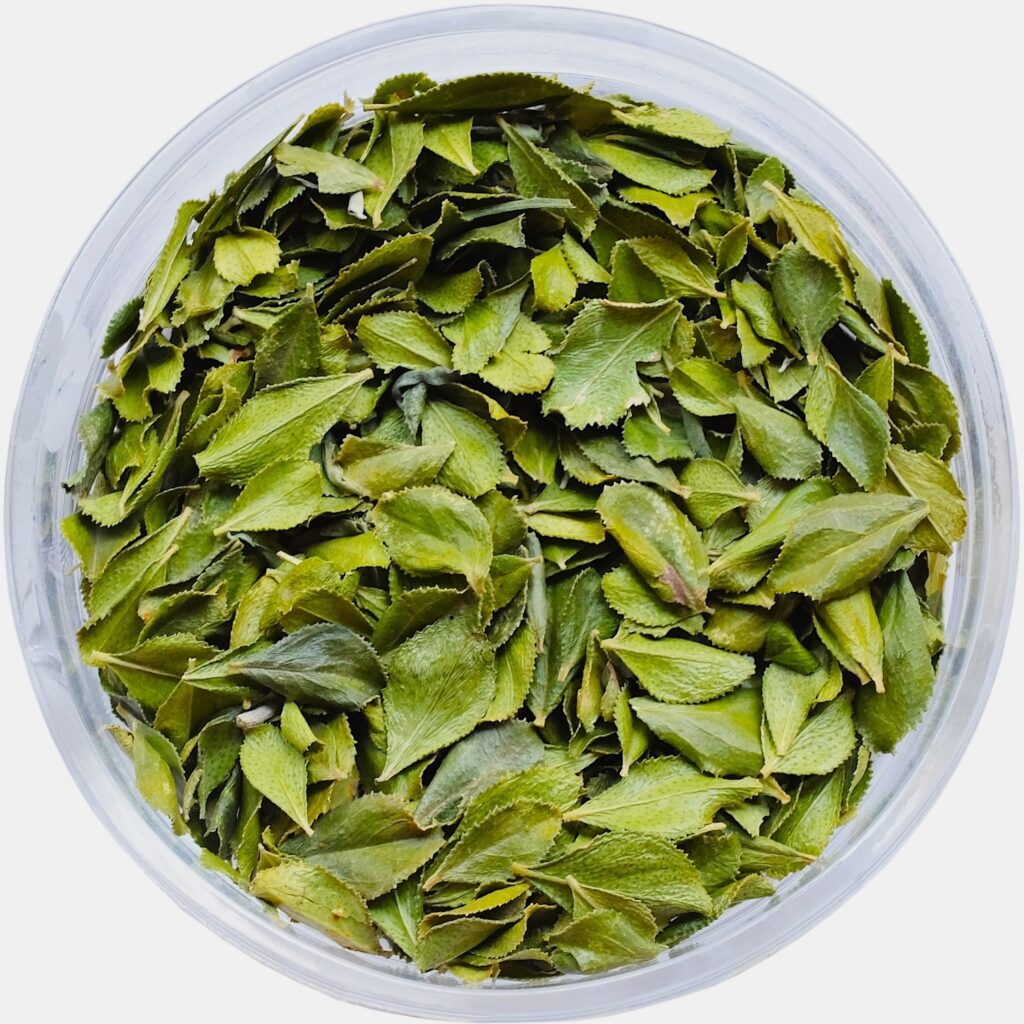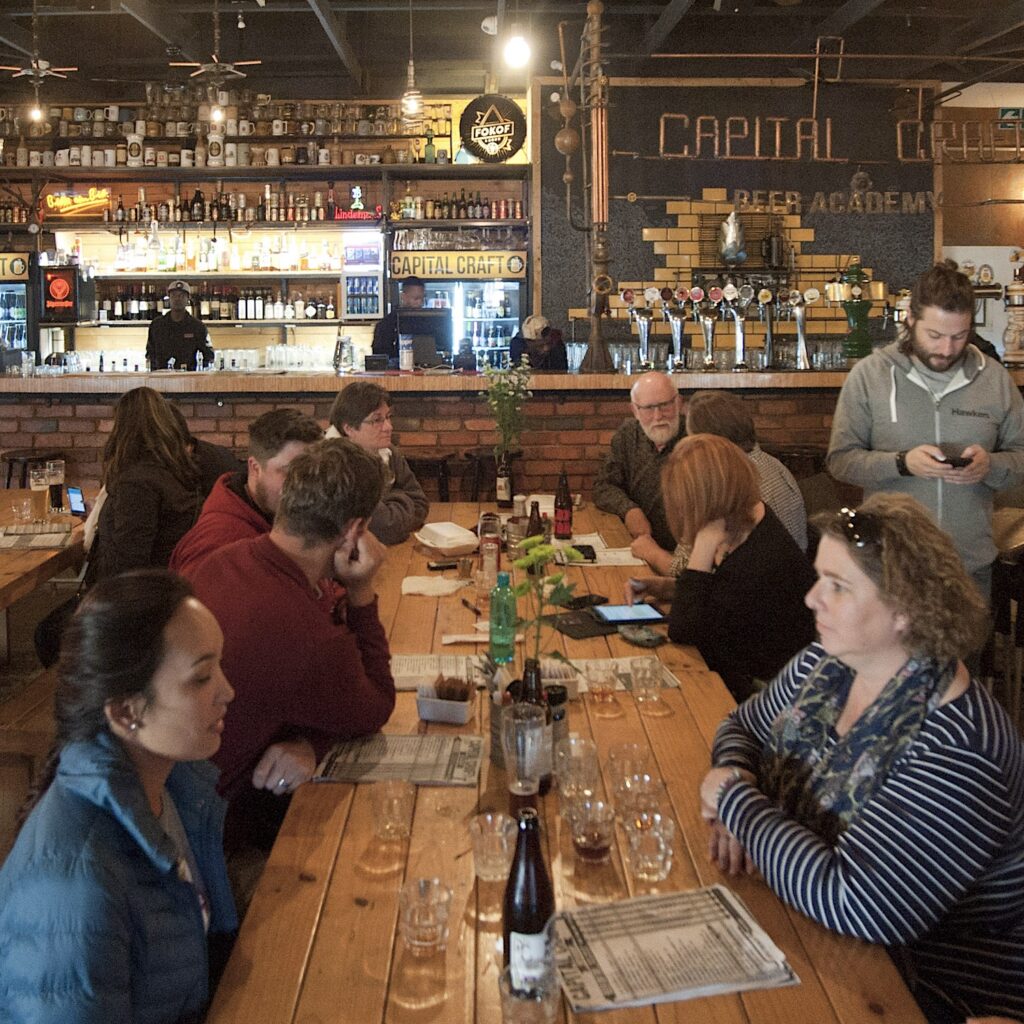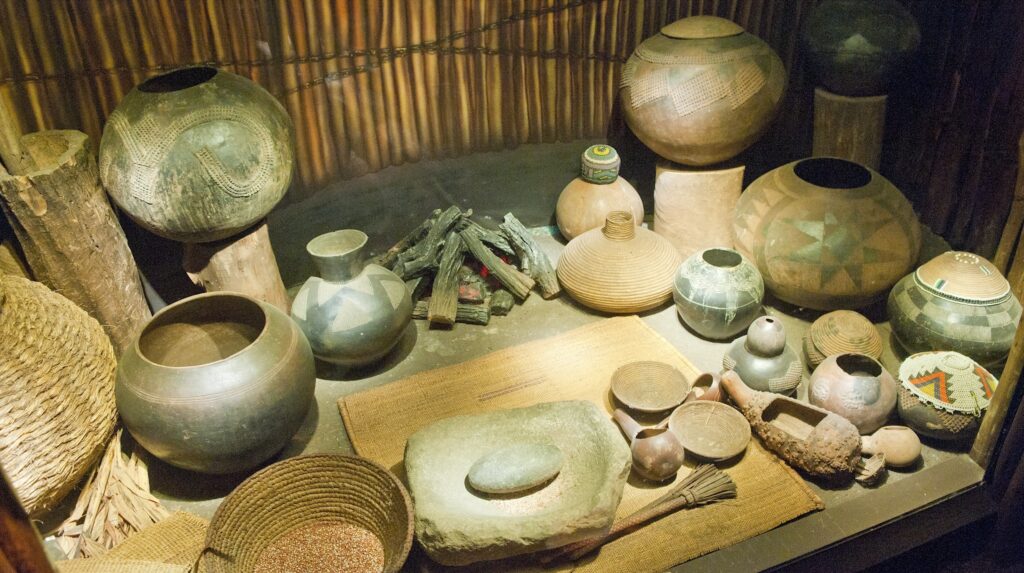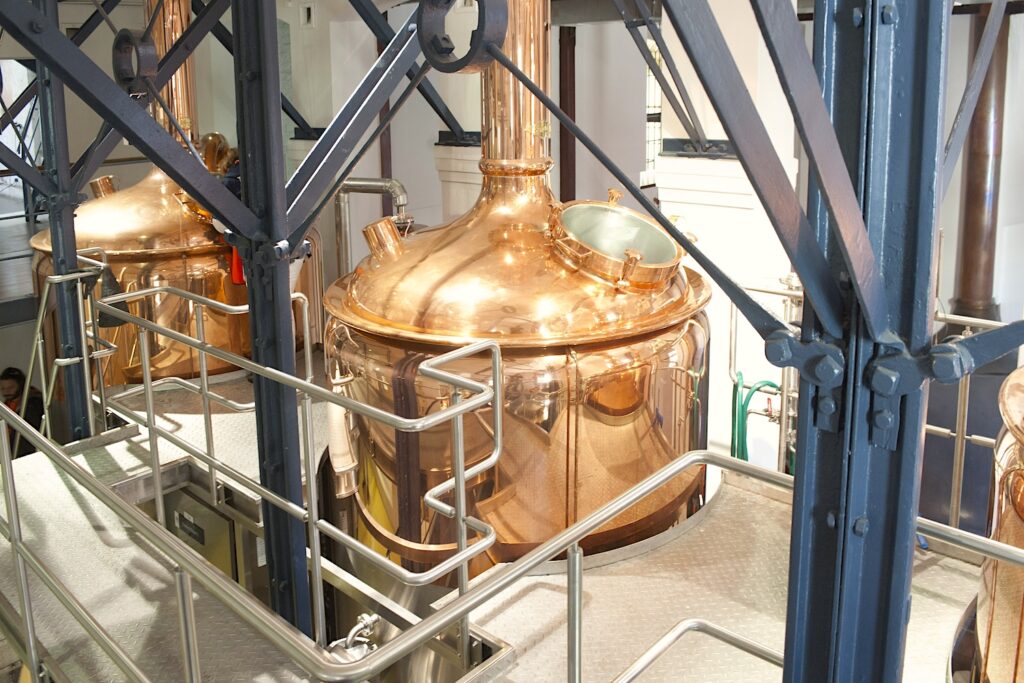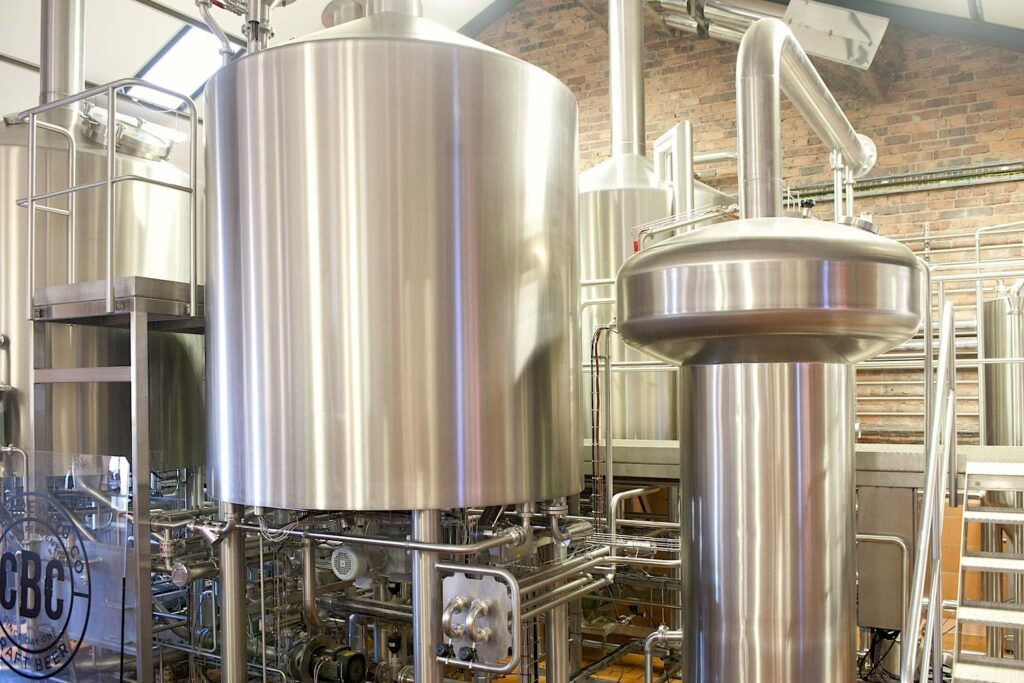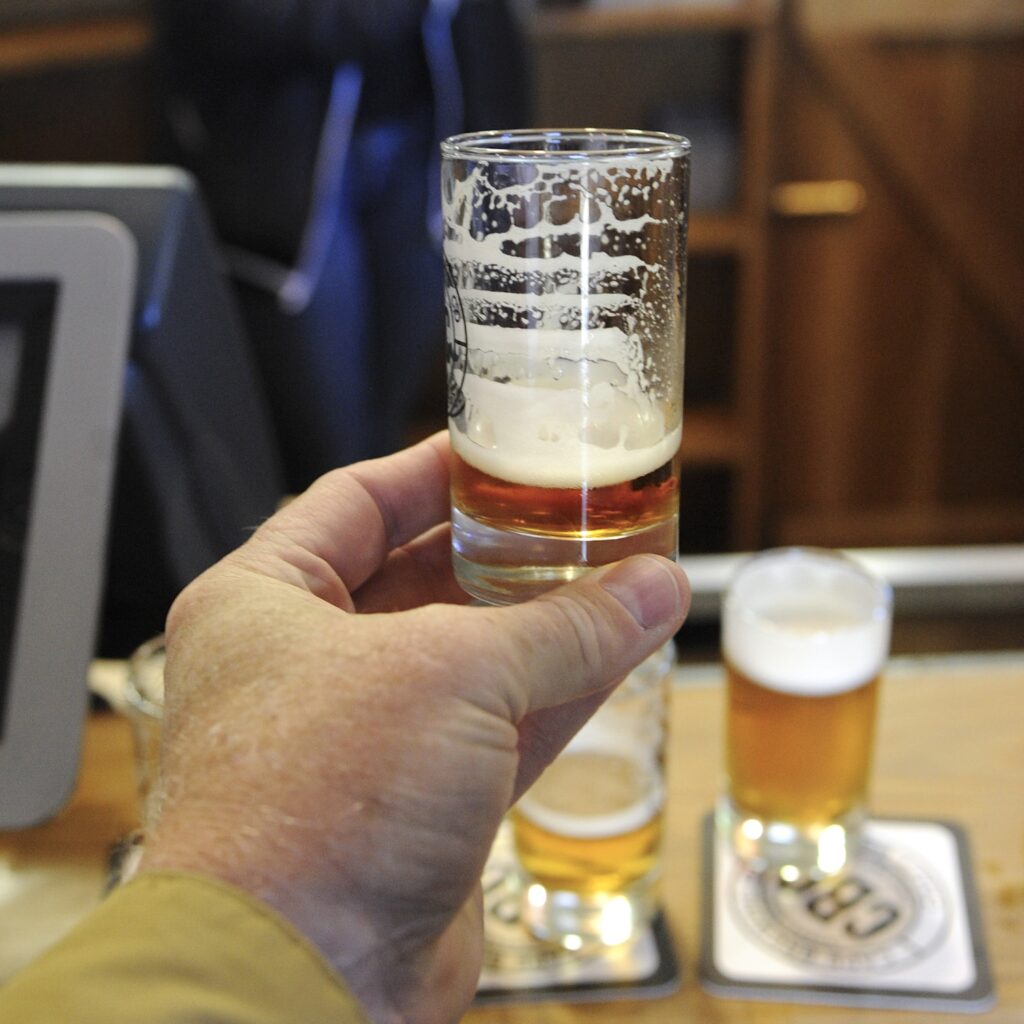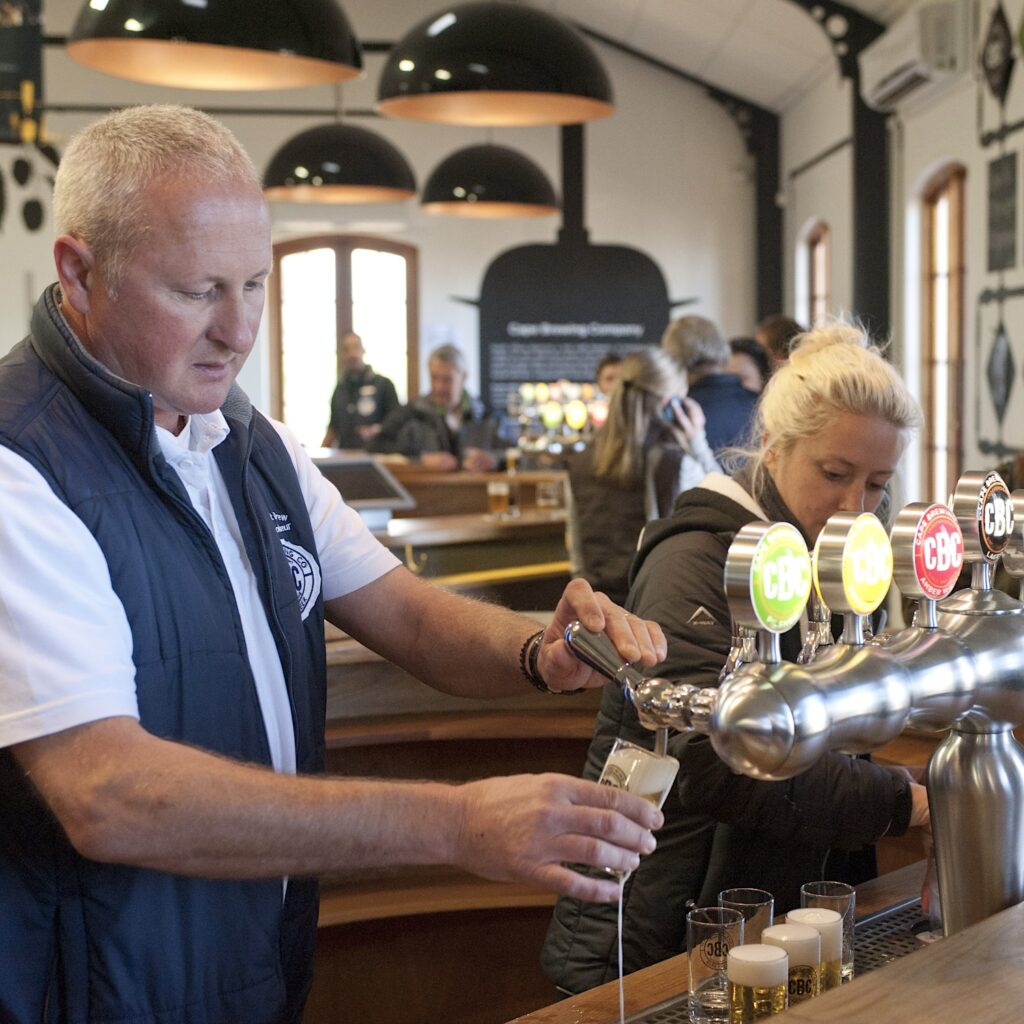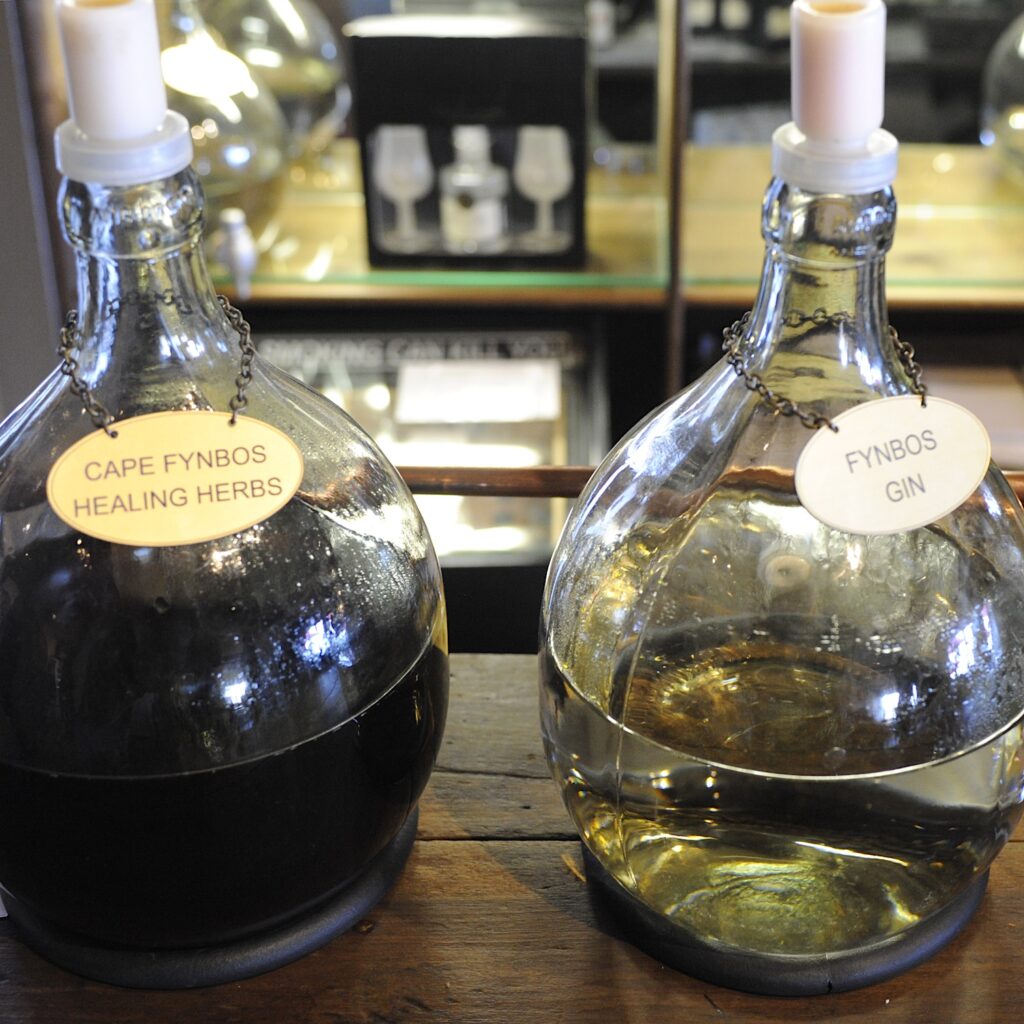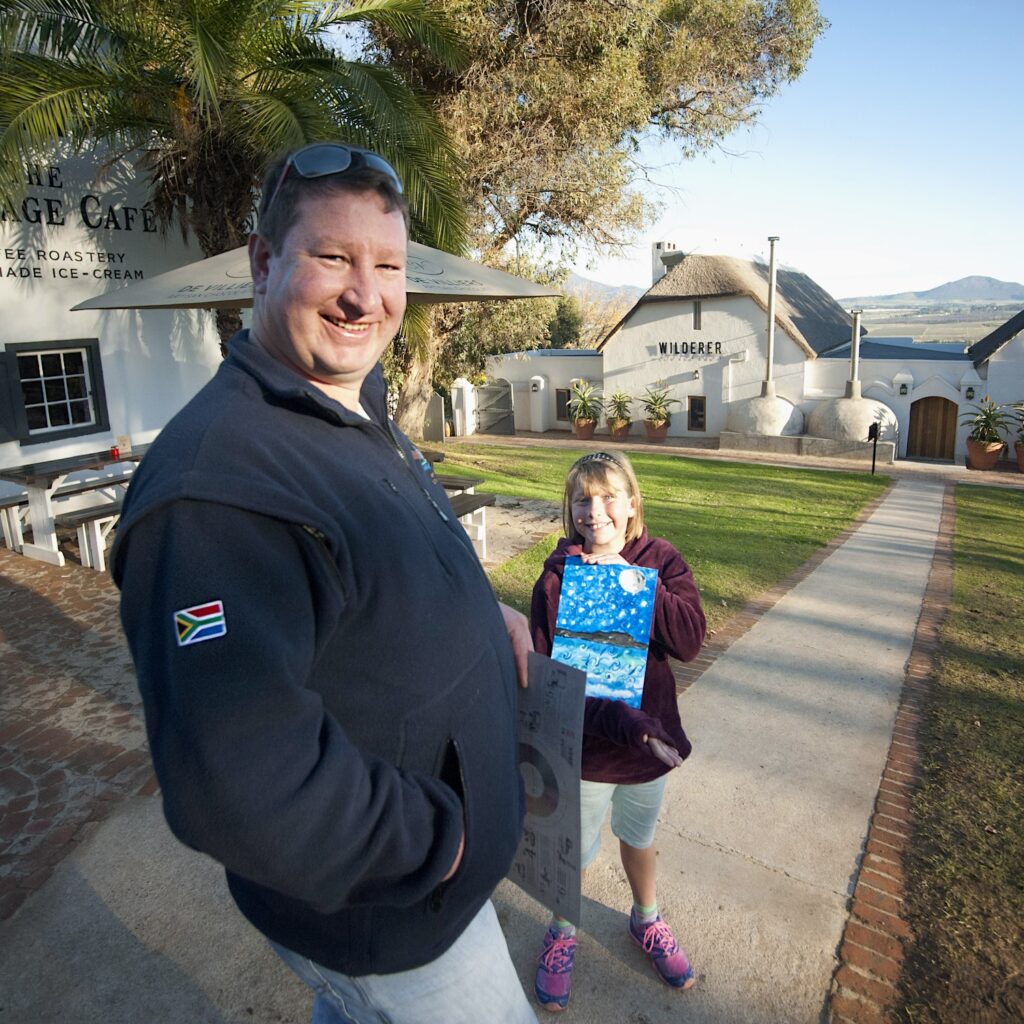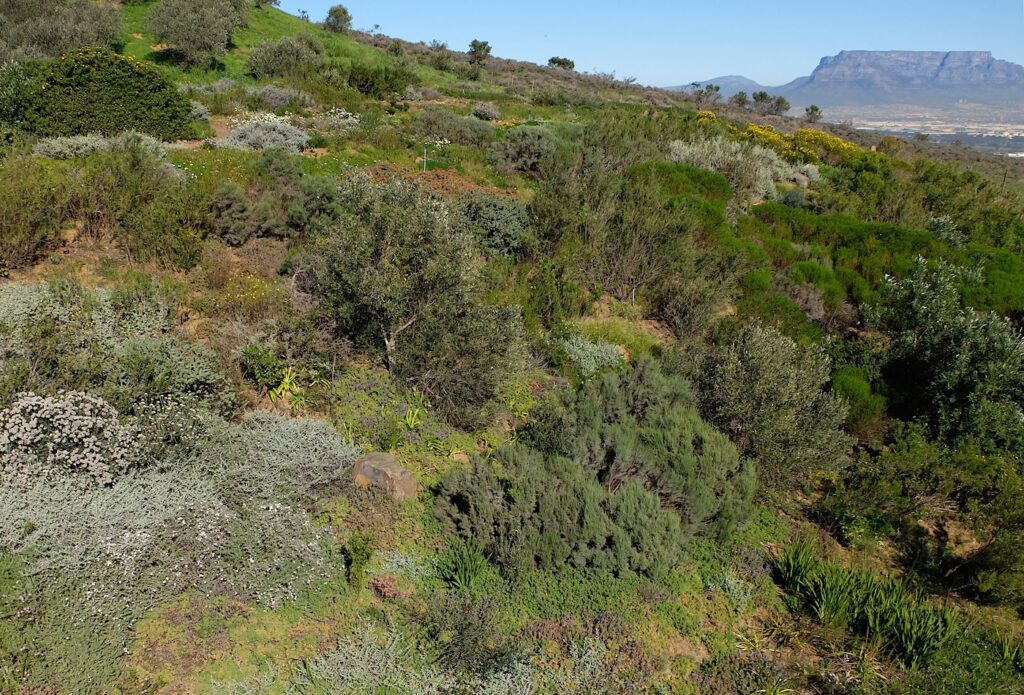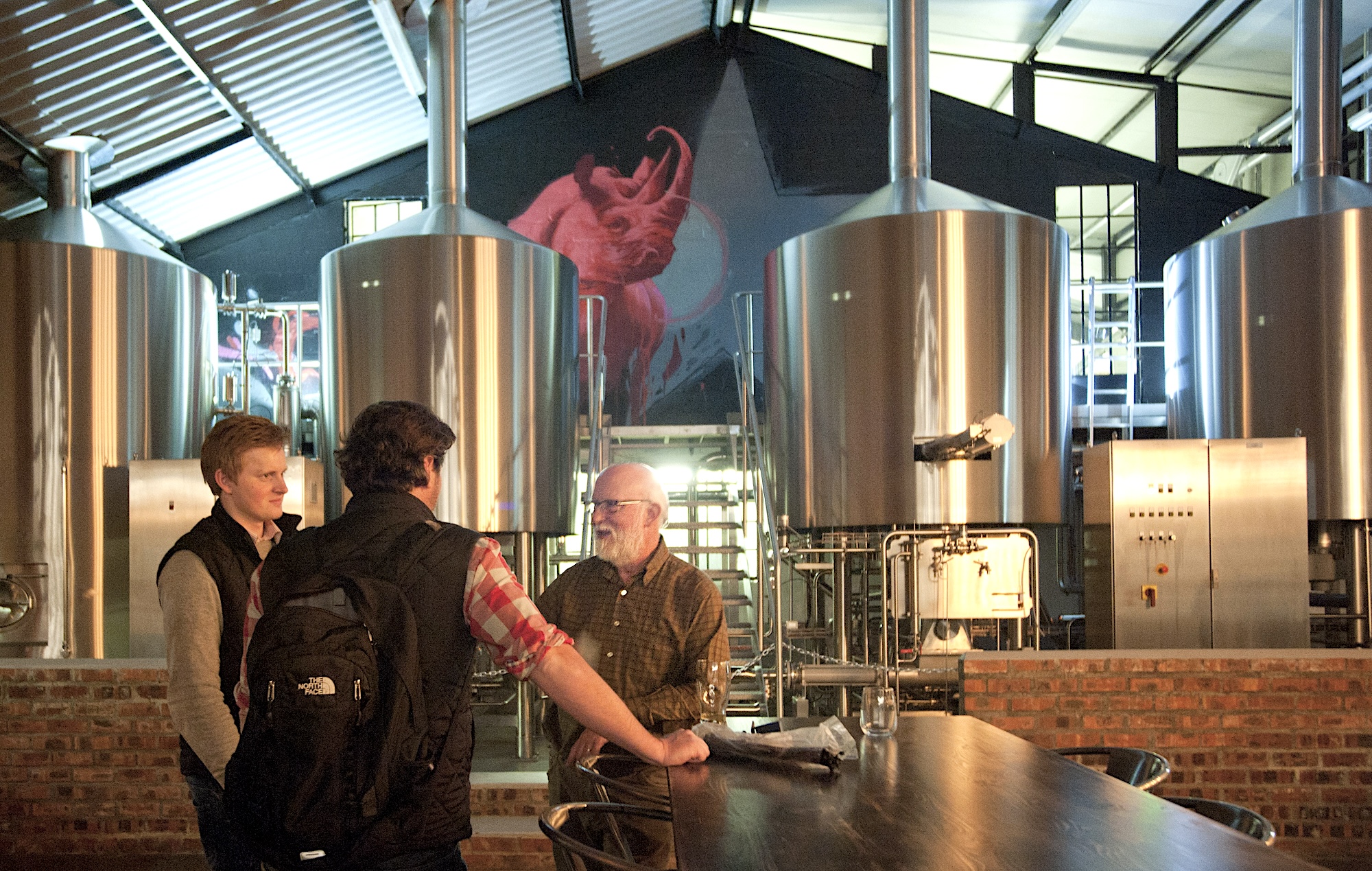© 2016, Randy Mosher
Above: Visiting the Jack Black brewery in Cape Town, shortly after their grand opening. That’s their brewmaster on the left.
These requests always pop up unexpectedly on email: “Would you consider coming and giving a talk at our beer event? We’ll pay your expenses.” I can’t always accept them, but I will if schedule, workload and other travel are favorably aligned.
This one was for Beer Boot Camp, two mini-conferences over two weekends, one in Johannesburg, and the other in Cape Town. The organizers were Julian and Wendy Pienaar, who own a nano-brewery called Just Brewing Co. on the outskirts of Johannesburg. For the week between, Wendy said, “We’ll show you around a bit.” That proved to be an understatement.
“Joburg,” as it is called, is a sprawling city built astride the richest gold deposit in the world. As a giant mining camp refashioned in concrete and glass, it reminds me of Houston. People there are a little apologetic about it, but it’s nice enough. Any big city has its charms; with some you just have to dig a little deeper.
But first, a trip out of town to a wildlife park for a quick look at some African nature. It’s rolling, scrubby country and the sanctuary delivers on all the big animals—elephants excepted—and included a charming little cave as a bonus. The place has some rustic lodging and a café, so after some safari-ing around, it’s beer time. A first round is sent back for being buttery, so we settle into the mainstream SAB beers that dominate South Africa: Castle Lager and Carling Black Label, which is a touch stronger and sweeter. The Carling there is different from the US version that was my father-in-law’s favorite back in the1970s. Both are hoppier than US mass-market lagers, at around 25 BU, I guessed.
The Boot Camp is a pretty typical beer event, with talks and a trade show with beer samples available, of course. There are about 120 people there and our presentations seem to be well received. Our hosts describe the Johannesburg scene as being a little behind compared to Cape Town, with For sure, no brewery has broken out in a big way there as several in the Cape Town area have, and brewers still view each other suspiciously as competitors. One barrier in Johannesburg is that brewers are forbidden from having a bar on premise, meaning taprooms and brewpubs are forbidden. It’s different in Cape Town, where the wine industry is a towering presence. This utterly silly rule needs to change, and hopefully the local brewers can embarrass the politicians into correcting this unfair oversight.
I am presented with a sample of a local herb called buchu along with a beer brewed from it, Loxton Lager. The small leaves have an intense minty/eucalyptus aroma along with a pronounced blackcurrant note and some gooseberry and kiwi as well. There’s a beautiful Khoisan story about the god of rain who comes to earth in the form of a buffalo, so enchanted by buchu’s aroma that he decides to hang around and provide rain to thank humanity for introducing it to him. It’s a prized ingredient in perfume, valued for the aromas I mentioned. There are two species (Agathosma betulina and A. crenulata), with a strong regional variation with the former, all of which affects the aroma. I hoped I would find some local flavors on this trip, and I’m seeing possibilities for this one.
Sunday, we have beers and lunch at Capital Craft in Pretoria, a suburb that is the legislative capitol of South Africa. The beer bar is a casual, funky place, with cheerful service. A sampler tray reveals what Julian has hinted at: this is a developing market, and not all the beers are where they should be in terms of quality. He’s right. Diacetyl in one or two, a couple of very astringent ones, and oxidation pretty much across the board. A third of the craft beer draft menu is craft brands that define themselves simply as “lager,” a sign that many consumers and brewers alike are uncomfortable with more than baby steps.
Our attempt to order an IPA on the second sampler is rebuffed: “Oh, no sir, that is a bad beer. It’s very bitter.” This, despite that fact that the beer, Devil’s Peak IPA, was one of the best brews we had on the whole trip, and astonishingly enough turned out to be the bar’s second best seller behind a strangely sweet ginger concoction that bore little resemblance to beer.
We had a pretty interesting group: The Pienaar family, including their 21-year-old son, Kyle, who is serving the role of brewer in their little nanobrewery, and his 11-year old sister Courtney, plus English beer writer Pete Brown and his wife Liz, Neva Parker from White Labs and her husband Glenn, Christina Schönberger from the international hop giant, Barth-Hass, Lebanese brewery entrepreneur Mazan Hajjar, now thriving with his Hawker Beer in Australia, and myself. It’s always amazing that you can throw a bunch of (nearly) total strangers together in the tight confines of bars and busses and get a jolly rolling party, but that’s always the way it is with beer people. It certainly was with this group.
After a bus tour around the center city, we end up at the SAB (South African Breweries, now part of SAB Miller) World of Beer. This is a promotional tourist attraction, easier to access than the SAB production breweries in the region, which are well beyond the core city. It’s heavily scripted, and just a little hokey as these kinds of things often are. They do acknowledge the presence of indigenous sorghum beer and even pass around a big bowl of it for sampling. It’s milky with a thick, creamy graininess, a little phenol in the nose along the lines of a weissbier, and a touch of acidity on the palate—pleasantly drinkable.
The tour comes with a couple of tasting tickets, which we swap for some of the company’s craft-like beers, which we find a little harsh and stylistically would not pass for craft in the US. The Castle Milk Stout on nitro is tasty: creamy, toasty and balanced. It’s good to hear that SAB is playing nice with the upstart craft industry, offering technical help at times and selling them malt and hops at an advantageous price. The currency (Rand) is weak compared to the Euro, dollar and many others, so the costs of raw materials and equipment are high, adding another burden on an already challenging business.
Tuesday, it’s off to Cape Town. We arrive during one of their famous winter storms, so it’s windy as hell and difficult to appreciate the sweeping beauty of the place. Wedged between Table Mountain and two restless oceans, it’s breathtaking, and now fully clad in lush green for winter as well.
The next day clears up beautifully and we’re off to the Newlands brewery, a 4 million hectoliter (3.4 million barrels) SAB facility on the original site of the Castle Brewery, built in 1895. We’re given the royal treatment by a retired third-generation brewer named Reto (pronounced (reeto) Jager. It’s a fairly typical modern brewery, with plenty of automation and a ton of process measurement and controls, employing about 200 employees in total. The original brewery buildings are at the core of it, and the whole compact thing is nestled into a residential neighborhood, so the brewery has to make sure truck traffic and brewery smells don’t disturb the neighbors. Reto is very generous with details, answering every technical question we can come up with. A newer addition is a gleaming copper Kaspar Schultz pilot brewery of 20 hectoliter (16.5 bbl) size, in which they are producing some experimental beers along craft lines. Unlike the ones we tasted at the World of Beer in Johannesburg, these beers brewed under the Newlands Springs name are genuinely delicious, from a classic hefeweizen to a golden ale hopped with a newer South African variety called Southern Passion, and a toasty pale ale.
In the evening, dinner and more beers at the Afro-Caribbean Brewery and Banana Jam Cafe, one of the pioneering Cape Town breweries. Owner Greg Casey is super hospitable, and with a Jamaican themed restaurant how can you not be? The beers are clean and enjoyable, and some, like coconut IPA, add to the Caribbean vibe. Several of the local brewers and super-geeks are there, celebrating the release of several Belgian-style ales produced by Shawn Duthie on the same brewhouse via a contract arrangement, all of which are solidly craftlicious. The Cape Town brewers are very friendly with each other, and we’ll keep seeing them pop in and out as we bounce around Cape Town over the next few days. Also present are Lucy Corne, a beer writer with two books on African beer (including this one specifically on South Africa (link), and who is starting a magazine and also happens to be married to Shawn, and Troye May, who interviews me the next day for his #BeerTime YouTube channel (link here). No wonder it’s a tight bunch. Lucy put together a nice review of the Beer Boot Camp (http://brewmistress.co.za/10-things-i-learnt-at-beer-boot-camp-2016/) as well.
Thursday, another beautiful day, and we head out for Paarl in wine country to visit Cape Brewing Company. It’s part of a gorgeous winery complex called Spice Route, which also includes a distillery. Cape Brewing is under the supervision of Wolfgang Koedel, a German national formerly in charge of production at a Spaten satellite brewery in South Africa. Tasting the beers, they’re unquestionably world-class. He’s old schooland Reinheitsgebot all the way. It’s a large, well-financed operation, with some Swedish as well as South African ownership. The system is a 30-hectoliter (26-bbl) Kaspar Schultz system, with an external SchoKo wort stripper that accomplishes what a conventional boil would, but with far less energy, giving the beer better protein structure for improved head retention and lower oxidation potential for better shelf life. I’m drooling from the combination of the equipment and the beers.
We taste them all, and every one’s a winner. Most notable are the double IPA fresh off the filter, which was thrillingly delicious, and an IPA using only Mandarina Bavaria, a newer, and quite expensive Bavarian hop. The beer’s aroma is like sticking your head in a bag of Chinese tangerine peel, the purest expression of that (or any) hop I’ve ever experienced. Unlike almost all other breweries, he’s a believer in using the best aroma hops all the way through the kettle, certainly the most expensive way to brew. He also prefers natural carbonation, so he caps the tank when the fermentation is nearly finished and allows the correct pressure to build. Since gas bubbles in any given beer are largely a matter of physics, I’ve never read any convincing explanation of why this method should be superior, but there’s no arguing with his results: the beers have an infinitesimally fine bead and very creamy texture and lace. This is the kind of brewery I never want to leave, especially on as fine a day and as beautiful a location as this.
Between their own beers and the ones they’re contracting for others, this location is getting close to its 30,000 hectoliter annual capacity once they add a few more tanks. “That’s it,” says Wolfgang, “and maybe we’ll build another one somewhere else.” He’s a huge figure in the South African scene that everyone looks up to, and a firm believer that if the small breweries help each other the business will be better for everyone.
One unfortunate necessity for most beer brewed in warm climates is pasteurization, and that’s the case for most South African beers, both draft and bottled. With no dependable cold-chain transport or storage, brewers choose between the devil they know—the instant aging effect of a short pasteurization—to the one they don’t: disastrous results when any small microbiological activity meets beer-unfriendly temperatures. The choice is consistent, but slightly dulled flavors vs. the potential for an horrific train wreck, so it’s not a hard decision. Of course, pasteurization magnifies bad process, so if your beer is not a graceful ager anyway, this will definite exacerbate those flaws. Also, as a general rule, if you’re pasteurizing, it’s best to filter, and the market there prefers clear beer for all but its hefeweizens.
The Wilderer distillery is located in the same Spice Route compound as Cape Brewing. Their unique Fynbos Gin is made with botanicals from the cape’s unique ecosystem, including wild dagga, buchu, devil’s claw and honeybush. At Forbidden Root, we’ve employed honeybush, a less tannic relative of rooibus. To me, the gin’s aroma profile is clearly gin-like, but with sweet spice, anise, red fruit, tree bark, black pepper and just a cool hint of mint at the end. Gin is particularly fascinating as it’s entirely a willful human creation. As long as it has that evergreen snap, it can incorporate just about any herb you want to throw in there, as long as the result is harmonious and layered.
Two more brewery visits to note. Devil’s Peak is a brewpub and production facility located on the second floor of an old Flatiron-type building in semi-sketchy street, so…perfect. They’ve got an older copper German system and are turning out some clean and modern beers, like Woodhead Amber, Black IPA, along with South Africa’s standout IPA, The King’s Blockhouse. Head Brewer JC Steyn, a former winemaker, has stepped into a leadership role in the craft industry there, and gave a talk at Boot Camp exhorting brewers to help each other for the sake of the industry. After the second Boot Camp we headed to Jack Black’s, a brand new production facility with a large taproom slathered with the raw iron and recycled wood that is the standard in the States these days. They’ve been contract brewing at another brewery up to now, and whatever they are doing is working, as they’ve built the place with a very top-end Rolec 30-hectoliter system. Founder Ross McCulloch recruited a young and very well educated young German brewer to run production. Beers include a very nice unfiltered Keller Pils, and others focused on hoppy beers in the American mold, including the popular Butcher Block Pale Ale.
These fast-growing, well-run breweries herald a new era of craft beer in South Africa and mark the passing of its first timid steps. They also should be a clear sign to the rest of the country’s craft breweries of what one really needs for success in terms of characterful beers, exciting branding, business acumen and relentless attention to quality. Beer is a complicated business, and you can’t be successful by just doing one or two of these things right. It’s got to be the total package or you might as well give it up.
Like the continent itself, there’s still a whole lot of uncharted territory. The pioneering beers stick pretty closely to American craft styles or their European predecessors, a necessary phase. Beers with a definable African character have yet to materialize. The possibilities are endless. There’s plenty of German influence in the local beer, and of course America is also a model now. But what about the English, who dominated for a century or more, and the Dutch before them who planted their colonial flags in the 1600s and presumably brewed some beer as best they could to sustain them far from home? What did that taste like?
Then there’s the botanicals. The Cape region is dominated by a unique flora known as fynbos, which literally means “good bush” in Afrikaans. There are dozens of low, scrubby plants in this community, and two of them, rooibus and honeybush are sold internationally as teas. We actually use the latter in our Forbidden Root Sublime Ginger, where it adds a deep fruity layer. But there are plenty more with interesting flavors and other biological properties. A quick roadside stop yielded a couple of interesting ones that resemble heather, one of which had an intense terpene-rich aroma of hops combined with black pepper. Perfect, in my mind for a saison, I think, provided it’s not toxic. And the fynbos ecosystem is just a small slice of Southern Africa’s immense biodiversity and ethnobotanical traditions, so really, there is no limit to the possibilities. If you have a spare few minutes, Google “drunken animals marula” and enjoy the YouTube spectacle. In addition to its entertainment value, this wild-harvested fruit is tangy and delicious and would be really great in beer
And of course this enormous content has a huge and widely varied culture of indigenous beers, in the South mostly based on sorghum grain (as opposed to the syrup pressed from the stalk we know in the US). I had lunch in Joburg with a young black brewer and his business partner who are experimenting with a sort of craft version of a millet beer, or possibly a millet version of a craft beer, both of which would be very exciting to see. I recently saw an article on a brewer named Clement Djaneh (link: https://munchies.vice.com/en/articles/ghanas-first-microbrewery-is-changing-the-way-beer-is-made-in-africa) in Accra, Ghana who is a little ahead of them, drawing attention for a wide range of millet-based beers of differing colors and flavors brewed in his garage-based nanobrewery. So, it’s coming.
The true flowering of the African beer revolution needs many things. First, a group of confidently creative and capable brewers, who organize together to protect and promote their industry is essential. Second, a much better level of education is needed, especially in the retail sector, so the wide variety of styles, ideas and flavors can be described and sold appropriately. The same kind of education will create a foundation of discerning and experimental enthusiasts who are confident enough in their tasting skills to send a beer back when it is bad or inappropriately served. Supplier infrastructure, from grain to yeast to equipment, needs to improve and expand. Finally, there are many nonsensical rules that limit consumer access to beer variety, prohibit useful and modern business models like taprooms and brewpubs and ultimately give big business extra advantages on top of the enormous economies of scale they already enjoy. As is always the case in these developing markets, people are in a hurry, but when you’re talking about societal change, even in a small sliver of the whole, it just takes time. I’ve been assuring everyone that they won’t recognize the place in two or three years, and it will be interesting to see if I’m right. I’m pretty sure I am.
Finally, I really should mention the wine. There’s a lot of it. The quality is very good and the prices are quite reasonable. We drank our fair of succulent sauvignon blanc, creamy chardonnay and meaty pinotage, South Africa’s unique and defining grape, as even beer people have to get away from it now and then. I can’t go into too much detail as that would require another whole article—and perhaps another trip.
I just want to give my heartfelt thanks to Wendy and Julian Pienaar for their tremendous effort to organize these conferences and especially for bringing me down and showing me and the rest of the presenters such a fun and illuminating good time. Best of luck to them and Kyle for whatever’s next for their company, Just Brewing. Also, to the breweries we visited, thanks for the great hospitality. And for the rest of the presenters and all the hangers-on, it was a delight to be in such fine company.
Below, top to bottom, left to right 1) The aromatic leaves of an herb in the citrus family called buchu 2) With the crew at Capitol Craft beer bar in Pretoria – my host Wendy is in the striped shirt 3) A display of indigenous Southern African brewing equipment on display at the SAB “World of Beer” in Johannesburg 4) The gorgeous copper pilot brewhouse at the SAB Newlands brewery in Cape Town 5) This brewhouse has all the latest bells and whistles – note the mushroom-shaped calandria on the right 6) This is what a mostly-empty glass of beer is supposed to look like – the rings of “Brussels lace” are a sign that the beer has a great texture and head 7) Cape Brewing Company’s brewmaster, Wolfgang Koedel, serving his faultless beer 8) Jugs of gin and botanical liqueur at the Wilderer Distillery in Paarl, South Africa 9) My sponsor Jules with his daughter Courtney showing off her artwork in front of the Wilderer Distillery 10) The Cape region’s unique “fynbos” ecosystem has many heathers and other species with aromatic and medicinal properties
